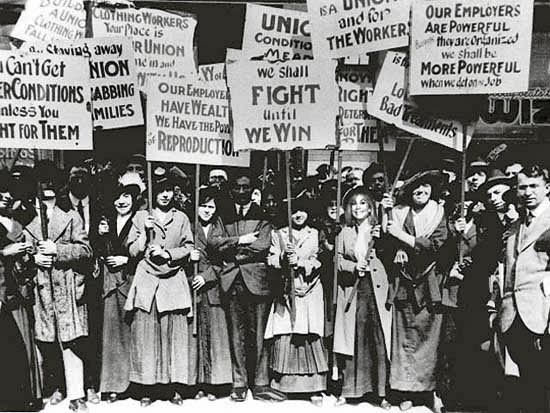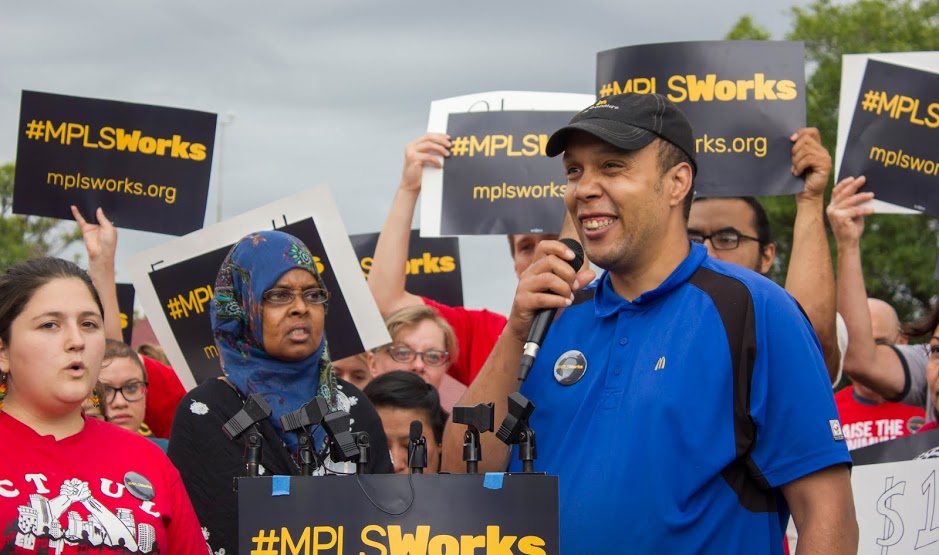By 9am on Tuesday, September 5th, 1882 New York’s City Hall was surrounded by rows of armed police officers both on foot and mounted on horseback. Assembled a full hour before a parade of jewelers, bricklayers, and carpenters were set to march to park and have a picnic: this was the scene at the start of the world’s first Labor Day. From that beginning, with a major city government literally defending itself from its residents, Labor Day has evolved and so has the role of cities in ensuring the rights of working people.
More than once U.S. cities have led the country as a whole, setting standards for their residents that would eventually become a national norm.

Police officers, firefighters, and teachers in New York City had municipal retirement plans over forty years before the creation of Social Security. Cities took the lead on providing for the unemployed years before Congress. Buffalo, Cincinnati, Kansas City, Milwaukee, and Louisville all created jobs programs for their residents in the early 1930’s years before the creation of Roosevelt’s Works Progress Administration.
Still, over the last three decades many U.S. cities have picked up on this old trend, asserting a more direct role in setting standards that improves the lives of workers. This shift is remarkable and is happening in Minnesota right now. The roots of this change, like the origin of Labor Day itself, are firmly set in conflict, as working people again and again have organized to make their jobs (and their cities) more livable.
The first general strike in U.S. history happened in 1835 in Philadelphia where workers were organizing for a ten-hour work day and a pay raise. In spite of the city’s arrest of the strike leaders and the mind-bending $2,500 fine the city imposed on them, the strike was uniformly successful. Twenty–thousand workers, from longshoreman to leather dressers, went on strike. The City Council conceded that the hours of those employed by the city setting a standard that spread not only across industries in Philadelphia but to other cities across the U.S.
Nearly sixty years later, in 1892, New Orleanians set city standards via their own general strike. This strike was led by 2000 to 3000 members of three racially integrated unions, the Teamsters, the Scalesmen, and the Packers. After a week on strike, the city’s employers started to bargain. They agreed to the demands of the two white-dominated unions, the Scalesmen and Packers, but refused to enter into a contract with the African-American majority union, the Teamsters. In response, the Scalesmen and Packers refused to return to work until employers offered the Teamsters the same terms. When joined by the other 46 member unions of New Orleans’ labor federation, they won a ten-hour day and overtime standard for industries across the city.
A century later, in Los Angeles, a strike by janitors, primarily Latinas, set city-wide standards that spread across the country. Los Angeles janitors had been losing ground. In 1983, a janitor could expect $7 per hour and family health insurance; by 1986, their wages were a mere $4.50 an hour with health insurance no longer available. It was in that context, in 1988, that the Justice for Janitors campaign was launched in the city. Led by members of the Service Employees International Union, janitors and community allies used a mix of employee walk-outs, street demonstrations, and political pressure to push for improved standards. After a 19 day strike, rather than winning improvements one employer at a time, building owners and contractors across L.A. agreed to give janitors a 22% raise over the next three years.
From the 1990s till today, more workers in more cities have started to take the initiative, finding local elected officials more responsive than their state or national representatives. The 1990’s saw the start of a Living Wage movement that passed 125 municipal ordinances including those in Duluth, St. Paul, and Minneapolis in 1997. Since 2004, Austin, Boston, Bridgeport, CT, Chicago, Hartford, CT, Jacksonville, FL, Kalamazoo, Memphis, Minneapolis, Portland, OR, Saint Paul, San Francisco, and Worcester, MA, have all acted to ‘Ban the Box’ that screened formerly incarcerated workers out of applicant pools for city jobs. The first municipal Earned Sick & Safe Time ordinance was adopted in 2006 and has since spread to nineteen cities. Since 2003, twenty-three cities have passed minimum wages that are higher than the federal standard.
Not unlike the period before the New Deal, working people in U.S. cities are raising standards (and expectations) that will pressure states and Congress to act.

With workers that are younger and more racially diverse than ever before, today’s cities are at the front end of demographic trends that will shape tomorrow’s states. Minneapolis and St. Paul are being shaped by the contributions of growing, more politically powerful communities of color. But the Twin Cities are not alone. Communities of color are growing more quickly in rural Minnesota than in the urban core; over the last ten years communities of color have grown by 75% in greater Minnesota compared to 40% in the Twin Cities. Over the next three decades communities of color are expected to account for all of the population growth in 35 of the state’s 87 counties.
Local governments, closer the ground and more directly accountable to the folks working low-wage jobs, are more likely to act. This year, the #MPLSWorks campaign has come together in order to guarantee earned sick and safe time benefits, create a fair workweek, end wage theft, and raise the minimum wage for working people in Minneapolis. Led by a coalition of labor and community organizations, like NOC and CTUL, the effort has gained traction with the city’s first female mayor, Betsy Hodges, and the most racially diverse and youngest City Council in the city’s history. Like workers in Philadelphia, New Orleans, and Los Angeles before them, the people of Minneapolis are poised to set standards that prod the rest of the state to act and inspire working people for generations to come.
